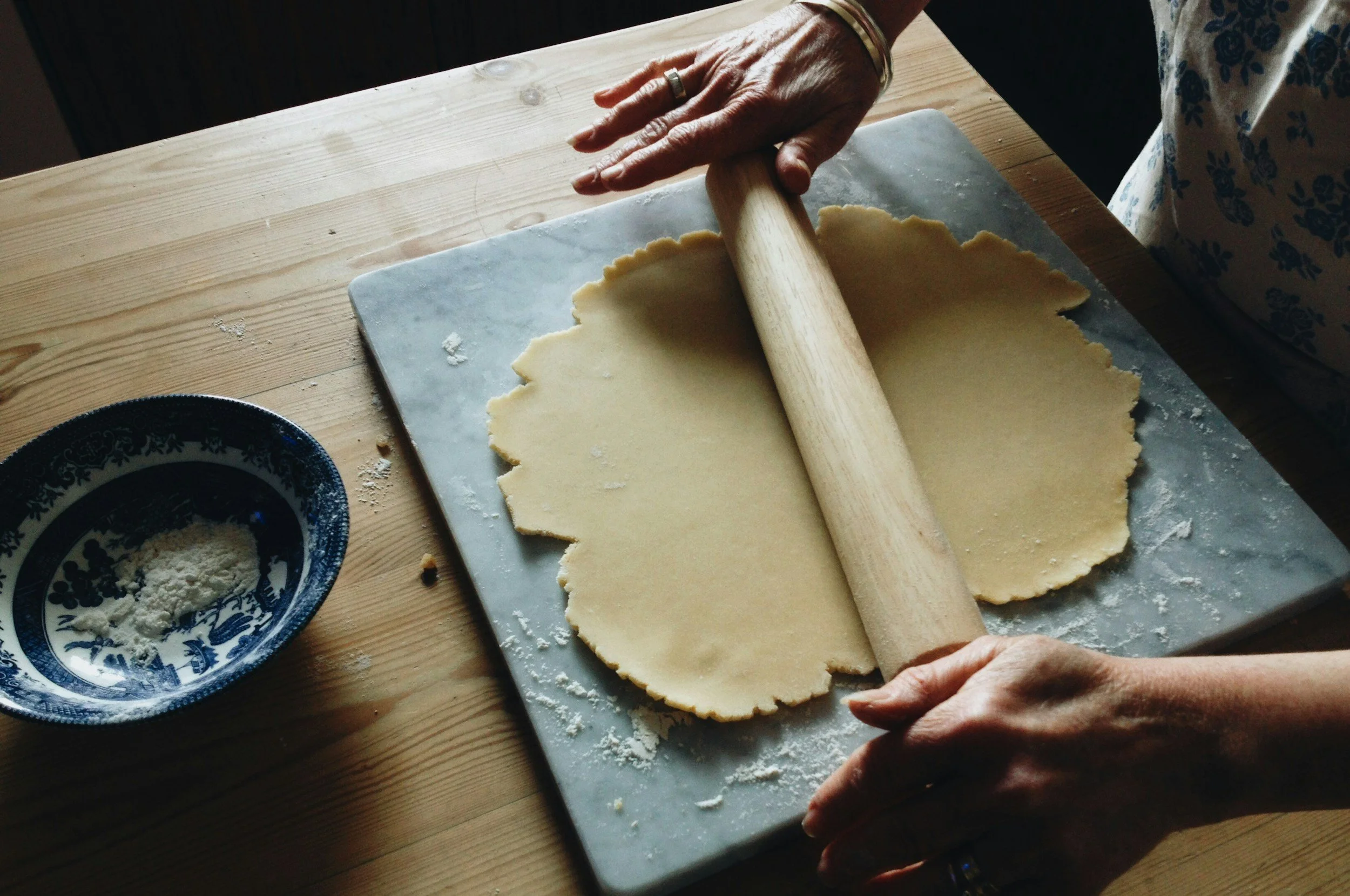The Midwestern Table
My mother made dinner every single night. We didn’t eat out. Ever. I grew up on sixties Midwestern food, colored by my mother’s aversions and preference. She loved her meals fiercely, but anything could be ruined by a bite of shell, bone, or gristle. No one likes biting down on whatever reminds us of our protein’s genesis, but for Mom it ground the meal to a halt. She preferred everything as processed as possible.
My mother also prized convenience. She was of a generation raised by mothers who made everything from scratch. My grandmother Lucille started chicken dinners by killing a chicken, and my mother had horrible childhood memories of decapitated dinners-to-be circling their barnyard. This probably accounted for her disdain for chicken, and fresh fish was harder to come by in South Dakota. Her father was a farmer, which is a three hundred and sixty-five-day-a-year profession. He didn’t take time off to go catch lake trout. And once he converted his farming operation to a feedlot, the family gave up pigs and chickens and devoted their time and table to beef, glorious beef, corn-fed and heavily marbled.
Mom had fierce brand loyalties. We had Velveeta on hand for our cheese (I was in my teens when I first tasted cheddar), and Miracle Whip instead of mayonnaise. She was a loyalist: Campbell’s soup, Uncle Ben’s rice, and when it came on the market, Kraft macaroni and cheese. She liked oil-packed tuna rather than water-packed, and no matter how I longed for the mermaid, she went for Charlie as far as label mascots. She preferred margarine to butter. She always preferred wheat bread (especially Vitabee) to white but kept white around for us. Peanut butter was a key source of nutrition in our household. Always Jif Creamy! Always! Mom ate a piece of peanut butter toast every day of her life, I believe.
Breakfast was Mom’s favorite meal. She loved pancakes and eggs. She tried to get us to eat that for dinner, but we hated it. Breakfast was my worst meal: pancakes, donuts, cereal, sweet rolls, oatmeal, anything like that. I hated sweets as a child, and I also hated eating in the morning. Mom should have just handed me a cup of coffee and let me skip breakfast.
It wasn’t just that so many breakfast foods were sweet. I was queasy as a child and the sounds eating would turn my stomach. If my brother was saying “Mmmm” and gulping his oatmeal, or my sister was slurping up her cereal milk, I’d start gagging. I couldn’t eat peanut butter until my teens because I’d heard too much of it being chewed. I know now that I have misophonia, but I didn’t figure that out until I was in my sixties. I’m not sure it was even discovered back then, but having a name for it wouldn’t have helped that pale-faced little girl retching over the toilet in 1966.
Understandably, breakfast was a no-go for me, but lunch was fine. It was a sandwich on white bread, because we did not like wheat. My favorite lunch was Campbell’s tomato soup (Mom made it with milk) and a grilled cheese (Velveeta, of course). Mom had a way with canned tuna, and those sandwiches were delicious when she would take the time to make them.
The sandwiches we made for ourselves were less artful. We ate lots of cotto salami with mustard, and bologna with margarine. I liked Braunschweiger (think liverwurst) very much, and olive loaf was my absolute favorite. These sandwiches were sometimes accompanied by the One True Chip, according to my mother, and that was a Lay’s. No other chip ever came into the house.
For dinner, there were two categories: dishes made with Campbell’s Cream of Mushroom Soup, and dishes made with Campbell’s tomato soup. That was it. Our pantry must have been stocked with lots of both. There was hamburger casserole, which had Cream of Mushroom soup, ground beef, rice, peas and yellow corn. It all cooked together and even though it visually reminded me of dog food, I liked it. There was tuna casserole, which had Cream of Mushroom soup, egg noodles, and one scanty can of tuna to feed a family of five. Adding canned peas to the plate did help a bit, as did the layer of crushed Lay’s that occasionally graced this casserole.
And speaking of chips, there was potato chip casserole, which had Cream of Mushroom soup mixed with a can of tuna and a bag of potato chips. It cooked down very small. No one I tell about it ever believes this was actually a recipe. In the family, we now refer to this as ‘salt casserole.’ I’m not sure what we put on the side. Maybe salt.
Shipwreck had ground beef and Campbell’s Golden Mushroom soup (I know! A variation!), rice, chopped veggies, sliced potatoes and canned tomatoes. And a bay leaf, one cannot forget the bay leaf. It had to bake in the big oval Le Creuset roaster for hours and hours. Occasionally Mom would take it out too soon and the carrots would be hard, which repelled me. This was a late addition to the repertoire, adopted from our wealthy Edina cousins and reflective of their more sophisticated tastes.
No South Dakota home was complete without a big electric skillet. Mom used hers often. Her Swiss steak was ground round steak simmered in (you guessed it) mushroom soup and served over mashed potatoes or rice. We used Uncle Ben’s real rice, usually, not the Minute Rice, because we were classy like that. Mom served canned green beans or peas with this. There was also round steak, which was round steak simmered in (yup) tomato soup and served over instant mashed potatoes (Potato Buds if you’re wondering). We had canned green beans or peas on the side.
There was goulash, my all-time least favorite dish of Mom’s. Everyone else loved it and I hated it, so it seemed to me that we had it all the time. It started with ground beef cooked with onion, then you added elbow macaroni and (ding!) tomato soup and cooked it all up. I refused to eat this, though of course I had to learn how to cook it, which I did, but that did not mean I was going to eat it. As a side note, this dish instilled in me such a deep loathing of elbow macaroni that I didn’t eat it until my thirties.
No mention of the electric skillet would be complete without pot roast. My mom made a pot roast like other women make toast. This was without a doubt my favorite dish she made–the browning of the onion, potato and carrot just so, the meat tender, the gravy so tasty, and always, I found the bay leaf. This was an outstanding dish.
We had other stuff, like chipped beef gravy. We never called it Shit on a Shingle, but that’s just what it was. It started with a package of that Buddig-style beef, which was cooked in margarine, then you made a roux, then added milk, salt and pepper, served on buttered white toast. Apparently this was such a complete meal that no sides were required.
We also had meatloaf. Mom’s meatloaf was ground beef, crushed Saltines, topped with a sauce made of tomato paste, Worcestershire sauce, yellow mustard, molasses and vinegar. This was served with baked potatoes and canned green beans or peas. Mom was super finicky about her meatloaf and was slightly miffed when I modified the recipe. I still love meatloaf. My kids love my meatloaf. It’s one of three recipes they have asked for, and my recipe is not Mom’s recipe. I am almost ashamed to admit that I use Campbell’s tomato soup for the sauce.
But we did not only eat the American classics! My mother introduced some international dishes to our table. Like, spaghetti! Before Ragu came on the market, she made it with a Schilling envelope and a can of tomato paste added to ground beef browned with a little onion. This savory sauce was served over regular spaghetti noodles, with garlic bread and an iceberg lettuce salad.
Tuna Chow Mein was as close as we got to Asian cooking. It started with (you guessed it) a can of Cream of Mushroom soup and a can of tuna, heated together in a saucepan. Then you added a can of La Choy Chinese vegetables and did not let it cook, as the canned vegetables would ‘lose important crunch!’ This was served over rice. And as I write this, I can taste how good this was, possibly because there were some vegetables involved, I don’t know.
After my older brother graduated high school and left for art school, and before my much younger brother ate real food, we went through a time when Mom made Hamburger Helper quite a bit. I think Mom liked it because you cooked it all in a skillet and divided it into four wee helpings and set it on the table and washed the skillet and you were done. I actually liked the sliced potato in brown gravy kind. Then one fateful night, we all got food poisoning from Hamburger Helper lasagna. We never ate it again.
When Mom didn’t feel like cooking, we ate a lot of frozen potpies (only Swanson). Sometimes Mom made hamburgers, hotdogs, or fish sticks–but she never ate fish sticks. We never, ever ate any fresh fish or shellfish, or any chicken. Part of this was Mom’s previously mentioned horror at biting a bone or bone chip. She would only eat Oscar Meyer wieners because there is never any bone in those, and Star-Kist tuna for the same reason.
I almost forgot desserts. Mom made excellent desserts: Tollhouse cookies, date bars, ‘Diet Demolishers,’ and fudge. Before there was a name for it, she had the most vicious PMS of any woman on the planet. She was mildly psychotic for at least one week a month, and chocolate assuaged it. So when she made fudge, it was generally eaten out of the pan while it was still soft.
When I was fifteen years old, I moved to Yakima, Washington, with my boyfriend. I found myself living in the southern part of America’s Fruit Basket. It was a revelation. I had barely ever tasted fresh fruit as a kid. I mean, raisins were considered fruit when I was growing up. And there I was, devouring seasonal stone fruit and apples that were not mealy Red Delicious.
But aside from my newfound appreciation for fruit, my eating habits didn’t change much. I had to cook dinner for my boyfriend every night, and I’d learned to cook in Mom’s kitchen. I replicated her recipes for the rest of my teen years, adding requests from my boyfriend, who had been raised in a family that ate real food. I learned about fish, zuchinni, fresh tomatoes, but chicken eluded me. When I was nineteen, I worked as a nanny and was taught to roast a chicken by my employer. My days of no chicken, no fresh fish were over.
My mother’s palate changed, too. Her tastes expanded in her later years, especially after she moved to Portland, Oregon in the seventies. Mom went on to develop a taste for fresh fruit, seafood, and chicken. The last meal I shared with her was seafood Egg Foo Yung from a good place in Poulsbo; delicate and excellent, and one of the few things she could eat after the cancer had gotten to her.
Despite the fact that I was raised on garbage, I remember most of Mom’s cooking with nostalgia, even though what she served is barely recognized as food today. Especially—well, I’ve actually saved the best for last. Mom would set up the special folding grinder. We’d all take turns helping her grind up Spam, Velveeta cheese, and sweet pickles. She’d mix this all together with Miracle Whip. Then she’d spread it between hamburger or hotdog buns, wrap them in foil, and bake it. It looked just like vomit in a bun. We loved it. My older brother came up with a name for it, and it lives on in our family lexicon as ‘Sweet Spameeta.’
Ah, Sweet Spameeta. You are long gone, but never forgotten. Just like my mother, who would be horrified if she were still alive to read this. I hope she wouldn’t be angry at me for writing it all down. I hope she’d be laughing herself silly.
-Karen G. Berry
Karen G. Berry lives and works in Portland, Oregon. She is interested in micro-societies, the strange and secret lives of children, and the heroic nature of everyday living. Karen's work has been published by Inknest, The Offing, HerStry, Flash Fiction, Thin Skin, Rust & Moth, Parks & Points, The Gilded Weathervane, Hot Pot, Panorama, Ekphrastic Review, and many other journals and anthologies, online and in print. You can learn more about Karen at her blog, I am Not a Pie.







